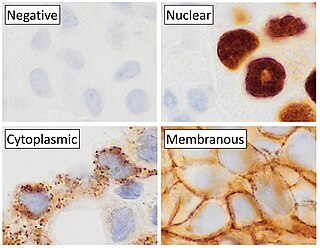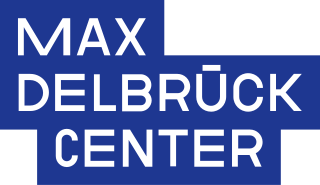
A biopsy is a medical test commonly performed by a surgeon, an interventional radiologist, or an interventional cardiologist. The process involves the extraction of sample cells or tissues for examination to determine the presence or extent of a disease. The tissue is then fixed, dehydrated, embedded, sectioned, stained and mounted before it is generally examined under a microscope by a pathologist; it may also be analyzed chemically. When an entire lump or suspicious area is removed, the procedure is called an excisional biopsy. An incisional biopsy or core biopsy samples a portion of the abnormal tissue without attempting to remove the entire lesion or tumor. When a sample of tissue or fluid is removed with a needle in such a way that cells are removed without preserving the histological architecture of the tissue cells, the procedure is called a needle aspiration biopsy. Biopsies are most commonly performed for insight into possible cancerous or inflammatory conditions.

Immunohistochemistry (IHC) is a form of immunostaining. It involves the process of selectively identifying antigens (proteins) in cells and tissue, by exploiting the principle of antibodies binding specifically to antigens in biological tissues. Albert Hewett Coons, Ernest Berliner, Norman Jones and Hugh J Creech was the first to develop immunofluorescence in 1941. This led to the later development of immunohistochemistry.
Cancer staging is the process of determining the extent to which a cancer has grown and spread. A number from I to IV is assigned, with I being an isolated cancer and IV being a cancer that has metastasized and spread from its origin. The stage generally takes into account the size of a tumor, whether it has invaded adjacent organs, how many regional (nearby) lymph nodes it has spread to, and whether it has appeared in more distant locations (metastasized).

Hybridoma technology is a method for producing large numbers of identical antibodies, also called monoclonal antibodies. This process starts by injecting a mouse with an antigen that provokes an immune response. A type of white blood cell, the B cell, produces antibodies that bind to the injected antigen. These antibody producing B-cells are then harvested from the mouse and, in turn, fused with immortal myeloma cancer cells, to produce a hybrid cell line called a hybridoma, which has both the antibody-producing ability of the B-cell and the longevity and reproductivity of the myeloma.

A biobank is a type of biorepository that stores biological samples for use in research. Biobanks have become an important resource in medical research, supporting many types of contemporary research like genomics and personalized medicine.

Ernst Wertheim was an Austrian gynecologist born in Graz.

University Hospital Heidelberg is a university hospital in Heidelberg, Germany and is with 1,991 beds one of the largest medical centers in the country. It is closely linked to Heidelberg University Medical School which was founded in 1388 and is thus the oldest within the Federal Republic of Germany.

The Max Delbrück Center for Molecular Medicine in the Helmholtz Association in Berlin is one of the 18 institutions that make up the Helmholtz Association. It combines basic molecular biology research with clinical research and is dedicated to the research foci of systems medicine and cardiovascular diseases. The research center is named after the Berlin-born biophysicist and Nobel laureate Max Delbrück. The center is headed by Maike Sander.

Automated tissue image analysis or histopathology image analysis (HIMA) is a process by which computer-controlled automatic test equipment is used to evaluate tissue samples, using computations to derive quantitative measurements from an image to avoid subjective errors.
A biorepository is a facility that collects, catalogs, and stores samples of biological material for laboratory research. Biorepositories collect and manage specimens from animals, plants, and other living organisms. Biorepositories store many different types of specimens, including samples of blood, urine, tissue, cells, DNA, RNA, and proteins. If the samples are from people, they may be stored with medical information along with written consent to use the samples in laboratory studies.
A tumor bank is sometimes also referred to as a Tissue Bank, since normal tissues for research are also often collected. However, this function is distinct from a Tissue Bank which collects and harvests human cadaver tissue for medical research and education, and banks which store Biomedical tissue for organ transplantation.
Lymph node metastasis is the spread (metastasis) of cancer cells into a lymph node.

Karl David Wilhelm Busch was a German surgeon.
The University hospitals of the Ruhr University of Bochum, German Universitätsklinikum der Ruhr-Universität Bochum, abbreviated UK RUB is a syndicate of six university hospitals and associated facilities of the Ruhr University of Bochum. Founded in 2008 by the merger of formally independent hospitals the UK RUB is now a major provider of health in the Ruhr Metropolitan Region treating over 400,000 patients per year with a strong commitment to research and teaching.

Estradiol undecylate, also known as estradiol undecanoate and formerly sold under the brand names Delestrec and Progynon Depot 100 among others, is an estrogen medication which has been used in the treatment of prostate cancer in men. It has also been used as a part of hormone therapy for transgender women. Although estradiol undecylate has been used in the past, it was discontinued .The medication has been given by injection into muscle usually once a month.
Patient derived xenografts (PDX) are models of cancer where the tissue or cells from a patient's tumor are implanted into an immunodeficient or humanized mouse. It is a form of xenotransplantation. PDX models are used to create an environment that allows for the continued growth of cancer after its removal from a patient. In this way, tumor growth can be monitored in the laboratory, including in response to potential therapeutic options. Cohorts of PDX models can be used to determine the therapeutic efficiency of a therapy against particular types of cancer, or a PDX model from a specific patient can be tested against a range of therapies in a 'personalized oncology' approach.

Kurt Karl Stephan Semm was a German gynecologist and pioneer in minimally invasive surgery. He has been called "the father of modern laparoscopy".
Thymidine kinase is an enzyme, a phosphotransferase : 2'-deoxythymidine kinase, ATP-thymidine 5'-phosphotransferase, EC 2.7.1.21 that catalyzes the reaction:
Ivo Meinhold-Heerlein is a German gynaecologist and obstetrician, honorary professor, university professor and deputy director of the Department of Gynaecology and Obstetrics at the University Hospital RWTH Aachen University. He is known for his work in the fields of molecular characterization of ovarian cancer.
Herbert Kuhl is a German gynecologist who has published extensively in the areas of estrogens, progestogens, menopause, hormonal contraception, and menopausal hormone therapy. His works include numerous original and review articles and several books. Kuhl is a member of many medical societies and has received various scientific awards.











